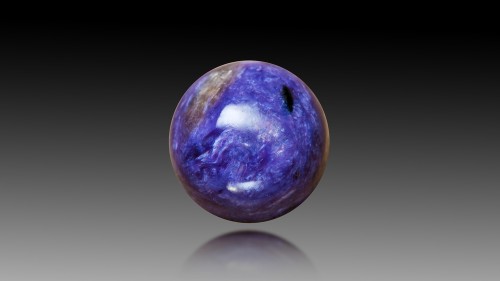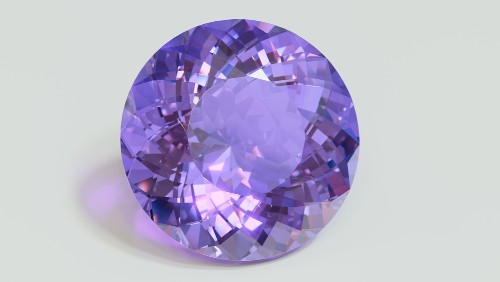Gorgeous Gemstones In Pantone’s 2022 Color of the Year

The Pantone color of the year is “Very Peri” — a stunning periwinkle blue hue with violet-red undertones meant to evoke confidence and curiosity, bolstering a creative spirit for 2022.

Of course, there are many dazzling gemstones similar to the latest Pantone shade. Learn more about these gorgeous stones.
Charoite

Charoite is technically considered a rock, but this rare silicate is a translucent lavender-to-purple color, with a beautiful pearly luster. The stone shows a swirling pattern and is often cut en cabochon. Its ability to be cut into larger sizes makes it even more special, and it’s often used to make vases and other decorative items.
A word of caution: avoid cleaning charoite with steam as it is sensitive to heat and pressure. It is best to use a soft brush, mild detergent, and warm water.
Sugilite

Jewelry lovers and connoisseurs adore the mesmerizing sugilite for its rare pink to purple color. Sugilite is opaque, and the more intense the stone’s color is, the more valuable it becomes. Manganese is to thank for its elegant hue.
Sugilite can be easily cut into larger stones, making it a good choice for things like ornaments, and its hardness of 6-6.5 — makes it an enduring beauty.
Although the stone does not require special care, it is best to use a soft brush, mild detergent, and warm water while cleaning.
Fluorite

The state of Colorado is the source of many mesmerizing gemstones—sapphire, garnet, tourmaline, quartz, lapis lazuli, amethyst, turquoise, and more. However, one of its lesser-known native gemstones is fluorite.
Adored for its beautiful palette of colors like yellow, green, blue, and violet, the stone has beautiful cubic crystals that shine even in their roughest form. Green fluorite, from Namibia, can masquerade as an emerald, especially after heat treatment, and Blue John is fluorite’s beautiful, banded variety.
This delicate gem holds a hardness of 4, making it somewhat soft and brittle. Avoid wearing fluorite during any activity where it could be knocked or scratched and store it separately from other gemstones to keep it safe.
Use a soft brush, mild detergent, and warm water while cleaning.
Violet Sapphire

Sapphire and ruby are both varieties of the same mineral, corundum. While blue is its most popular color, you can find the beautiful stone in almost every color. Padparadscha sapphire, is a rare pink-orange stone.
In some sapphires you may see a star pattern when cut en cabochon. Treatments and enhancements to this stone are common, so it’s important to ensure your gemstone is accompanied by a GSI gemstone report.
Sapphires have a hardness of 9 on the Moh’s scale, right after diamonds, which are a 10.
Chalcedony

Chalcedony has been used in gems, beads, and carvings for years. It is colorless in its pure form, but trace elements in its crystals can bring colors to the light.
Chalcedony can have different names based on its color and properties. The translucent, single-color stones are sold under the name “chalcedony.” Chalcedony with distinct banding is called “agate.” Jasper is the opaque variety of any color it shows. Dark green stones with red spots are known as “bloodstone,” and “chrysoprase’ is a translucent apple-green that contains nickel. And that’s just the start of the list!
Chalcedony has a hardness of 7, making it hard enough for all jewelry types. Dyeing is a common enhancement but must be disclosed prior to the sale. Buyers should opt for gemstone reports from credible labs such as Gemological Science International, which will provide all the important details about your gemstone.
It is best to clean a chalcedony with mild detergent, warm water, and a soft brush.
Amethyst

The mesmerizing purple variety of quartz, amethyst is adored by jewelry lovers worldwide. Its intense color and clear crystals are what makes it special and can be found in colors from pale lilac to deep reddish-purple.
Amethyst gets its color from iron and is often treated with heat to enhance the purple color. Most consumers prefer its rich, intense varieties, but lighter shades — like the soft lavender “Rose de France” — are gaining popularity. But don’t be fooled: any violet or purple hue outside of amethyst’s color range is likely a variety of quartz. The purple varieties of spinel, garnet, and sapphire may look similar to amethyst, but their gemological properties will help you tell them apart.
With a hardness of 7, amethyst is good enough for any jewelry setting. It can also be used as beads, carvings, and other ornamental objects.
It can be sensitive to extreme heat, and if your stone is dyed or fracture-filled, it is best not to avoid ultra-sonic cleaners.
Jadeite

Jadeite jade is known for its toughness, durability, and longevity, and can be passed down for generations without affecting its appearance and quality. Jadeite jade can be found in several colors—with green being its most common—and has a secondary type, nephrite jade, that’s similar in appearance.
Jade can be treated and enhanced for better quality and appearance using dye or impregnation, which must be disclosed at the point of sale. A gemstone report from a credible lab like GSI is always recommended.
It is safest to use mild detergent, warm water, and a soft-bristle brush for cleaning.
Spinel

A beautiful gemstone found in a myriad of shades, spinel has often been confused with ruby or sapphire. Its varieties are named by their color and range from deep crimson to pastel blue and pink, to purple, grey, and black.
While it is colorless in its purest state, spinel’s colors appear thanks to trace elements within its crystal. Along with its color, the stone’s brilliance, clarity, and hardness make it a great choice for jewelry.
The stone requires no special care, but it is always best to store gemstone jewelry away from other stones and harmful chemicals.
Tourmaline

If you love stunning and saturated hues, tourmaline is the gemstone for you. There are more than 30 mineral species inside tourmaline, available in almost every color, and it often displays color zoning that brings more than one of them to light.
Cut en cabochon, some varieties of this stone exhibit a cat-eye effect. A gem cutter’s delight, tourmaline can be sliced, or its rough crystals faceted to showcase its beauty in different ways. It has a hardness of 7-7.5, which is durable enough to wear in everyday jewelry.
Tanzanite

Tanzanite, discovered in the 1960s, is relatively new in the gemstone world, but it has been quickly embraced by jewelry lovers and connoisseurs for its striking color—a beautiful blue often blended with rich purple hues.
In the late 1960s, Tiffany & Company introduced tanzanite to the market, renaming the stone from its technical “blue zoisite,” to “tanzanite,” after its country of origin. The world swooned.
Tanzanite’s most natural color—a perfect blue—is rare. Most stones on the market are brown, then heat treated to enhance their color. But in its rare form or not, tanzanite’s “pleochroism” is always something special. Explore the stone from its different angles, and you’ll see an intense blue, purplish red, or even greenish-yellow.
About The Author
Debbie Azar is the Co-Founder and President of Gemological Science International (GSI), one of the largest gemological organizations in the world, and a distinguished leader in the global diamond and jewelry industry. As an executive with extensive knowledge of the jewelry and gem lab industries, her entrepreneurial skills and vision have helped GSI achieve rapid and continuous growth worldwide, establishing 13 leading-edge gemological facilities on four continents. She currently serves on the boards of the Jewelers Vigilance Committee, Responsible Jewellery Council, and Jewelers for Children, and is a member of the 24 Karat Club of New York. She has been featured in Forbes, Daily Mail, Good Morning America, Bloomberg, Bloomberg Businessweek, Fox Business, Fox5, CBS2, BOLDTV, Varney&Co, The Street, and NASDAQ, among others.
















































